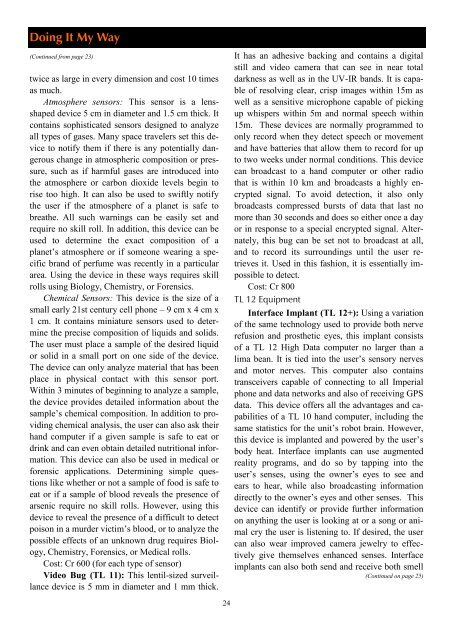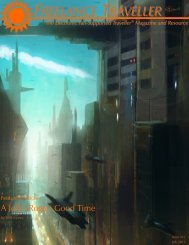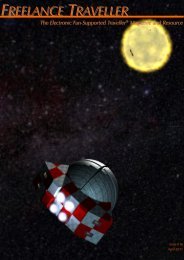Doing It My Way - Freelance Traveller
Doing It My Way - Freelance Traveller
Doing It My Way - Freelance Traveller
Create successful ePaper yourself
Turn your PDF publications into a flip-book with our unique Google optimized e-Paper software.
<strong>Doing</strong> <strong>It</strong> <strong>My</strong> <strong>Way</strong><br />
(Continued from page 23)<br />
twice as large in every dimension and cost 10 times<br />
as much.<br />
Atmosphere sensors: This sensor is a lensshaped<br />
device 5 cm in diameter and 1.5 cm thick. <strong>It</strong><br />
contains sophisticated sensors designed to analyze<br />
all types of gases. Many space travelers set this device<br />
to notify them if there is any potentially dangerous<br />
change in atmospheric composition or pressure,<br />
such as if harmful gases are introduced into<br />
the atmosphere or carbon dioxide levels begin to<br />
rise too high. <strong>It</strong> can also be used to swiftly notify<br />
the user if the atmosphere of a planet is safe to<br />
breathe. All such warnings can be easily set and<br />
require no skill roll. In addition, this device can be<br />
used to determine the exact composition of a<br />
planet‘s atmosphere or if someone wearing a specific<br />
brand of perfume was recently in a particular<br />
area. Using the device in these ways requires skill<br />
rolls using Biology, Chemistry, or Forensics.<br />
Chemical Sensors: This device is the size of a<br />
small early 21st century cell phone – 9 cm x 4 cm x<br />
1 cm. <strong>It</strong> contains miniature sensors used to determine<br />
the precise composition of liquids and solids.<br />
The user must place a sample of the desired liquid<br />
or solid in a small port on one side of the device.<br />
The device can only analyze material that has been<br />
place in physical contact with this sensor port.<br />
Within 3 minutes of beginning to analyze a sample,<br />
the device provides detailed information about the<br />
sample‘s chemical composition. In addition to providing<br />
chemical analysis, the user can also ask their<br />
hand computer if a given sample is safe to eat or<br />
drink and can even obtain detailed nutritional information.<br />
This device can also be used in medical or<br />
forensic applications. Determining simple questions<br />
like whether or not a sample of food is safe to<br />
eat or if a sample of blood reveals the presence of<br />
arsenic require no skill rolls. However, using this<br />
device to reveal the presence of a difficult to detect<br />
poison in a murder victim‘s blood, or to analyze the<br />
possible effects of an unknown drug requires Biology,<br />
Chemistry, Forensics, or Medical rolls.<br />
Cost: Cr 600 (for each type of sensor)<br />
Video Bug (TL 11): This lentil-sized surveillance<br />
device is 5 mm in diameter and 1 mm thick.<br />
<strong>It</strong> has an adhesive backing and contains a digital<br />
still and video camera that can see in near total<br />
darkness as well as in the UV-IR bands. <strong>It</strong> is capable<br />
of resolving clear, crisp images within 15m as<br />
well as a sensitive microphone capable of picking<br />
up whispers within 5m and normal speech within<br />
15m. These devices are normally programmed to<br />
only record when they detect speech or movement<br />
and have batteries that allow them to record for up<br />
to two weeks under normal conditions. This device<br />
can broadcast to a hand computer or other radio<br />
that is within 10 km and broadcasts a highly encrypted<br />
signal. To avoid detection, it also only<br />
broadcasts compressed bursts of data that last no<br />
more than 30 seconds and does so either once a day<br />
or in response to a special encrypted signal. Alternately,<br />
this bug can be set not to broadcast at all,<br />
and to record its surroundings until the user retrieves<br />
it. Used in this fashion, it is essentially impossible<br />
to detect.<br />
Cost: Cr 800<br />
TL 12 Equipment<br />
Interface Implant (TL 12+): Using a variation<br />
of the same technology used to provide both nerve<br />
refusion and prosthetic eyes, this implant consists<br />
of a TL 12 High Data computer no larger than a<br />
lima bean. <strong>It</strong> is tied into the user‘s sensory nerves<br />
and motor nerves. This computer also contains<br />
transceivers capable of connecting to all Imperial<br />
phone and data networks and also of receiving GPS<br />
data. This device offers all the advantages and capabilities<br />
of a TL 10 hand computer, including the<br />
same statistics for the unit‘s robot brain. However,<br />
this device is implanted and powered by the user‘s<br />
body heat. Interface implants can use augmented<br />
reality programs, and do so by tapping into the<br />
user‘s senses, using the owner‘s eyes to see and<br />
ears to hear, while also broadcasting information<br />
directly to the owner‘s eyes and other senses. This<br />
device can identify or provide further information<br />
on anything the user is looking at or a song or animal<br />
cry the user is listening to. If desired, the user<br />
can also wear improved camera jewelry to effectively<br />
give themselves enhanced senses. Interface<br />
implants can also both send and receive both smell<br />
(Continued on page 25)<br />
24

















